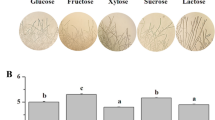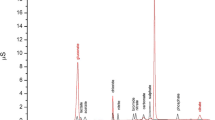Abstract
A mean of 2.7 g fusarenon-X (FUS-X)/L was produced in cultures ofFusarium sp Fn-2B on SSA, a synthetic medium containing sucrose and asparagine. When culturing Fn-2B on several other media, or using otherFusarium strains, much lower concentrations of FUS-X or nivalenol (NIV) were obtained. The SSA-incubations with Fn-2B in an optimal volume of 100 mL were stopped just before reaching maximal FUS-X concentration and the start of conversion to NIV. FUS-X was extracted from the 22 days old cultures and partially purified on a silica gel column. It was then hydrolysed to NIV, which was rechromatographed on silica and crystallized.
The purity and the chemical and physical properties of the NIV produced were investigated. Potential sources of error when quantifying NIV were also studied.
Similar content being viewed by others
References
Scott PM (1989) The natural occurrence of trichothecenes. In: Trichothecene mycotoxicosis: pathophysiologic effects. Volume I. Beasley VR (Ed) CRC Press, Boca Raton, pp 1–26.
Hedman R, Pettersson H, Engström B, Elwinger K and Fossum O (1995) Effects of feeding nivalenol-contaminated diets to male broiler chickens. Poultry Sci. 74:620–625.
Hedman R, Pettersson H and Lindberg JE (1996) Absorption and metabolism of nivalenol in pigs. Arch. Anim. Nutr. In press.
Tatsuno T, Saito M, Enomoto M and Tsunoda H (1968) Nivalenol, a toxic principle of Fusarium nivale. Chem. Pharm. Bull. 16: 2519–2520.
Morozumi S, Wauke T, Hitokoto H and Kudoh Y (1988) Synthetic medium for production of trichothecene mycotoxins by Fusarium species (In Japanese). Japan. J. Food Microbiol. 5: 131–136.
Mulé G, Logrieco A and Bottalico A (1995)Fusarium sp. FN-2B: a controversial strain genetically close toFusarium poae. Mycotoxin Res. 11: 53–58.
Nirenberg HI (1981) A simplified method for identifyingFusarium spp. occurring on wheat. Can. J. Bot. 59: 1599–1609.
Lauren DR, di Menna ME, Greenhalgh R, Miller JD, Neish GA and Burgess LW (1988) Toxin-producing potential of someFusarium species from a New Zealand pasture. New Zealand J. Agric. Res. 31: 219–225.
Cappellini RA and Peterson JL (1965) Macroconidium formation in submerged cultures by a nonsporulating strain ofGibberella zeae. Mycologia 57: 962–966.
Tanaka T, Hasegawa A, Yamamoto S, Matsuki Y, Ishii K and Ueno Y (1986) Producibility ofFusarium sp. Fn 2B for nivalenol and fusarenon-X on cereal substrates. Proc. Japan Assoc. Mycotoxicology No 24: 60–62.
Morooka N and Tatsuno T. (1970) Toxic substances (Fusarenon and nivalenol) produced byFusarium nivale. In: Proc. First U.S.-Japan Conference on Toxic Micro-organisms. Herzberg M (Ed) US, New York, pp 114–119.
Lee YW and Mirocha CJ (1984) Production of nivalenol and fusarenoneÄX byFusariumtricinctum Fn-2B on a rice substrate. Appl. Environ. Microbiol. 48: 857–858.
Ueno Y, Ueno I, Tatsuno T, Ohokubo K and Tsunoda H (1969) Fusarenon-X, a toxic principle ofFusarium nivale-culture filtrate. Experientia 25: 1062.
Ueno Y, Ueno I, Amakai K, Ishikawa Y, Tsunoda H, Okubo K, Saito M and Enomoto M (1971) Toxikological approaches to the metabolites ofFusaria. II. Isolation of fusarenon-x from culture filtrate ofFusarium nivale Fn 2B. Japan J. Exp. Med. 41: 507–519.
Grove JF (1970) Phytotoxic compounds produced by Fusarium equiseti. Part V. Transformation products of 4ß, 15-Diacetoxy-3, 7-dihydroxy-12, 13-epoxy-trichothec-9-en-8-one and the structures of nivalenol and fusarenone. J. Chem. Soc. C. pp. 375–378.
Jarvis BB, Mazzocchi DB, Ammon HL, Mazzola EP, Flippen-Anderson JL, Gilardi RD and George CF (1990) Conformational effects in trichothecenes: structures of 15-hydroxy C4 and C8 ketones. J. Org. Chem. 55: 3660–3662.
Fujimoto Y, Morita Y and Tatsuno T (1972) Recherches toxicologiques sur substances toxiques deFusarium nivale: Etude chimique des toxinns principales, nivalenol, fusarenon-X et nivalenol-4,15-di-O-acetate. Chem. Pharm. Bull. 20:1194–1203.
Tatsuno T, Fujimoto Y and Morita Y (1969) Toxicological research on substances fromFusarium nivale III. The structure of nivalenol and its monoacetate. Tetrahedron Lett. 33: 2823–2826.
Bennett GA and Shotwell OL (1990) Criteria for determining purity ofFusarium mycotoxins. J. Assoc. Off. Anal. Chem. 73: 270–275.
Kanhere SR and Scott PM (1990) Heptafluorobutyrylation of trichothecenes using a solid-phase catalyst. J. Chromatogr. 511: 384–389.
Kientz CE and Verweij A (1986) Trimethylsilylation and trifluoroacetylation of a number of trichothecenes followed by gas chromatographic analysis on fused-silica capillary columns. J. Chromatogr. 355: 229–240.
Author information
Authors and Affiliations
Rights and permissions
About this article
Cite this article
Hedman, R., Pettersson, H. Purification and quantification of nivalenol. Mycotox Res 12, 79–90 (1996). https://doi.org/10.1007/BF03192266
Received:
Accepted:
Issue Date:
DOI: https://doi.org/10.1007/BF03192266




